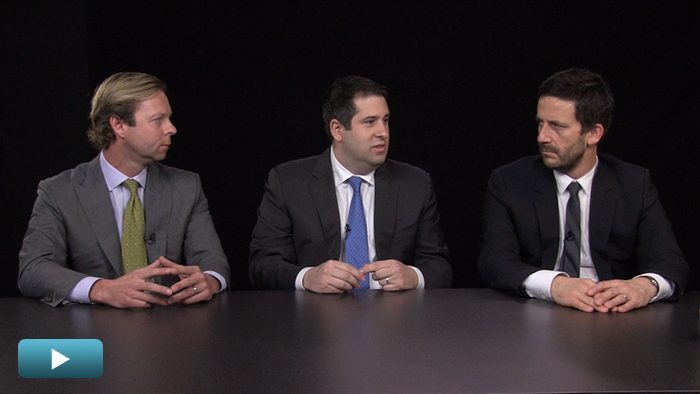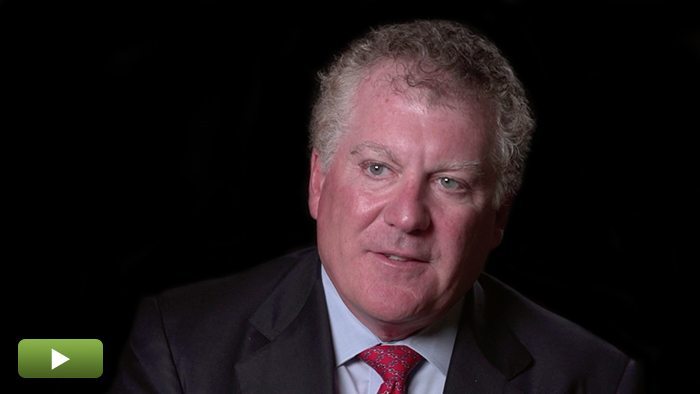DC Pensions’ Potential $180B Private RE Bet
Defined contribution plans are starting invest in private real estate, a move that could lead to more than $180B of new capital flows to the sector, according to Prudential Real Estate Investors’ David Skinner.
Transcript Download Transcript
DC Pensions’ Potential $180B Private RE Bet
With David Skinner and Leonard Kaplan of Prudential Real Estate Investors
Zoe Hughes, PrivcapRE: I’m joined here today by David Skinner and Leonard Kaplan of Prudential Real Estate Investors. Gentlemen, thank you so much for joining me today.
Leonard Kaplan, Prudential Real Estate Investors: Thank you.
David Skinner, Prudential Real Estate Investors: Thank you.
Hughes: The shift in the pension world from defined benefit to defined contribution has been widely reported. And for the alternatives industry, particularly for commercial real estate managers, it does have major implications over how they raise capital in the future. Dave, you lead Prudential Real Estate Investors’ DC group, and Len, you’re the portfolio manager for the group. Dave, give me some insights into the reality of that shift from DB to DC, and what it actually means for real estate managers.
Skinner: If you look at the DB world today and at the DC world, over the long run, the average DB plan has over–performed the average individual in a DC plan by 100 to 150 basis points depending upon what period you’re looking at. On top of that, if you look at returns over time, the average DB plan has a lot less volatility than what you would see in the average DC participant’s portfolio. So, this notion of the DC plan sponsors now looking at their participants and saying, “What do we need to do to improve outcomes?”—it’s all around really taking the best practices around DB and moving into to DC. And what plays into that is that looking at asset classes that are prevalent in a DB plan that you don’t have in DC today. Private real estate, private equity, hedge funds, and liquid asset classes that have not been traditionally in a DC plan are now being looked and adopted by plan sponsors.
Hughes: So did the DC plans not have any exposure to real estate? Because I would have thought that, on an asset allocation basis, they would have had some exposure.
Skinner: They do have exposure today, and where they’ve had exposure is in using REITs, securities. Because securities have offered liquidity that ups to today has been a key factor and driving point of plan sponsors to include an asset class in their plan. So, REITs have been used, they’ve been used very well, and REITs have performed very well for planned sponsors. But the notion of including direct real estate has been something that most plan sponsors haven’t included because there hasn’t been liquidity or daily valuation, which has been one of the key requirements to participate in DC. That’s changing. Three years ago, if you were to ask a plan sponsor to look at private real estate, their first question would be, “Can I get daily valuation, daily liquidity?” Now, the question is “How can I optimize an investment outcome for my participant, and what will it take to get there?”
Hughes: Len, to bring you in at this point, give me an idea as to how Prudential Real Estate Investors actually structures the products. That will give us a good base to talk about the challenges and how you overcome them.
Kaplan: Our DC–oriented real estate fund is a fund–of–fund structure, so investors buy shares in our DC fund, which then makes investments in the underlying funds, which are large commingled funds. They get the benefit of a 420 to 440 property diversified portfolio, which are otherwise not available to individuals like you or me.
Hughes: And who are you actually targeting when we talk about defined contribution? What type of plans are you targeting, who are you targeting within that?
Kaplan: We’re targeting what we call “target dates” funds—professionally managed funds that act very much like defined benefit plans. They have long–term planning, they’re diversified and they invest in alternative assets as well as stocks and bonds. They act very much like a DB plan, so that’s the benefit that an individual will get by investing in that plan versus just an individual choosing stocks or bonds themselves.
Hughes: You talked about the challenges, and liquidity is obviously a very big one, but also daily valuations. I know there have been private real estate managers who have tried to tap the retail market, and that’s been a real challenge. How do you overcome liquidity first?
Skinner: Liquidity is by setting up a fund of fund we’re really combining REITs and direct real estate. And the REIT is really the component that provides the daily liquidity, so you can trade in and out of the fund on a daily basis. Again, coming back to the question of “Do I need 100% liquidity in a targeting fund?” Ninety percent of your target day funds is going to be in liquid assets, and considering the cash flow that constantly comes in from a DC plan that’s not prevalent in DB plans, you’ve got cash flows coming in from contributions. So, we don’t see the need to have 100% liquidity, and we believe that by offering a REIT allocation you get the amount of liquidity that a plan sponsor is requiring. We have a product that has an allocation of 25% to REITs, and we have a product that has an allocation of 15% REITs. Because we’re finding that planned sponsors who have already been investing are saying they don’t need that much liquidity or that much REIT exposure. So, it’s really coming down to the marketplace sponsors and consultants starting to say, “What are our liquidity needs?” Let’s form a smart decision around the investment decision given the real liquidity, not the perceived liquidity need.
Hughes: What about cash, because obviously that’s going to be a damper in terms of returns as well? Do you have to keep cash on hand?
Skinner: We keep a very small amount anywhere from 1% to 2%, and that’s just to handle daily cash flows that come in and out of the fund.
Hughes: What are the DC plans talking to you about in terms of daily valuations? That’s obviously a significant challenge for private real estate managers across the board. How do you overcome?
Kaplan: They do require daily valuations—any fund that has daily trades requires daily valuation. Our underlying fund is due quarterly, third–party appraisals, so every quarter all 400 to 500 assets are appraised by a third–party independent from Prudential. In addition, we need to provide a daily value of the DC funds, and the way we do that is we hire a second independent fiduciary for our investors to do the daily valuation. They’re conflating that time period from a quarter to a day, and the theory behind that is we want to do an even allocation of value during the quarter. We want to recalibrate the value on a daily basis as any information comes in, whether it’s macro—Janet Yellen is changing interest rates—or micro, a lease is signed, a new valuation comes in at the property level. They want to reflect that in the daily value every day, because we want people to trade in and out on as fair a basis and as current a basis as possible.
Hughes: What about risk appetite? You said obviously the DC plan is looking to maximize returns because of the outperformance of the defined benefit plans versus defined contributions. So, what is the risk appetite? Where is the risk tolerance?
Skinner: When you’ve got a target date fund, the starting point you’ve got the fund that’s going to be allocating anywhere from 80% to 90% to equities. Because the notion is you got another 40 years before the person is retiring. As the person, the investor gets close to the retirement, the target date will de-risk the equity and have exposure into fixed income and other asset classes. We like to say that, early on in the beginning of the glide path, we believe REITs are the way to go, because you’ve got greater returns, you’re going to get greater volatility. But you have a long time horizon to make up any shortfalls or corrections, and you can manage the volatility because it’s an equity diversification. As you get closer to retirement, we are hearing from client sponsors that, as my participants are five or 10 years away from retirement, that’s where I can’t afford to have them in over–allocation equities because we can’t afford a correction. That’s where we see private real estate because of its low correlation to equities and its low volatility compared to REIT is a good spot to be in the glide path as you get closer to retirement.
Hughes: Obviously, you’re talking about private real estate that says to me very much core, income–producing—not necessarily the higher, obviously looking for the 18%+ returns. Do you see the DC plans ever moving up the risk spectrum in terms of bringing perhaps more value–add opportunistic style strategies earlier into the target date funds?
Skinner: Where the marketplace is today, they have to get comfortable just with core, but there are plan sponsors who are much more pioneers in this space. And they’re investing in opportunistic real estate, private equity and so forth. Because, again, they’re looking at the long–time horizon and they’re looking to optimize. While I don’t see it as something that sponsors are ready to jump into, there are some sponsors out there who are already there. So, it’s just not where the main market is.
Hughes: Len, you mentioned leverage, which is a critical question when you look a private real estate. What’s the appetite for leverage? What really is the tolerance that the plan sponsors are looking at?
Kaplan: For DB and DC plans as well, the core funds have about 20% to 30% leverage. That’s where most people are comfortable, when you see peak–to–trough drops in real estate even at the worst markets you might see a 30% to 40% drop, which is what you saw in 2008. So, even at a 20% to 30% leverage, you’re pretty safe to ride through a cycle. When you start getting above that, that’s when you get the higher volatility and your NAVs can change a lot quarter to quarter, which is not the appetite we’re seeing from DC plans. We spoke to many sponsors and many consultants as we were developing these products. They were very clear—we want to see core–type real estate for our funds.
Hughes: Talk to me in regards to the marketplace—the options out there for the DC funds when they’re looking to bring in real estate.
Skinner: Three years ago, when I started in this role, I reached out to 30 sponsors. And I had one sponsor who said they were interested in looking at the asset class, and actually invested in it. Most of the other investor sponsors I talked to gave me a meeting because I knew them and they were my friends, so they said, “Let’s come in and hear about it.” Today, I’m getting a call once a month from a number of different sponsors and consultants saying, “Let’s come in, talk and understand what you’re trying to do. Because we are very interested in looking at real estate.” That’s from the sponsors’ community. From the real estate side, three years ago, there were four or five managers who had products and had track record. Today, there are anywhere from eight to 10 managers out there—some just launching products at the end of the year. But, more importantly, the industry has come together and is starting to work together to look at how we have conversations in the DC plan space to educate the marketplace and also create some common practices where possible around how the mechanics can work. A few years ago, an organization called the Defined Contribution Real Estate Council was formed. There were nine founding firms and, within a year, the nine founding firms grew to 30 members. Clearly, the real estate marketplace is starting to realize it’s a different conversation and a different education process that you need to have with a DC plan sponsor.
Hughes: It may be very difficult to quantify the scale of the capital that could come in from DC plans, but can you give us an estimate as to how big an opportunity this might be for commercial real estate and for private real estate?
Skinner: If you look at the growth of the DC market, there are estimates that it’s going to be as much as in excess of $7 trillion in the next 10 years. There are many who are saying that half of those assets will be in target–date funds and half of the target–date assets will be in custom TDFs. The custom TDF market, where plan sponsors are creating their own glide path and then choosing their own investments, is where the opportunity is for real estate, for the most part. So, you could be talking about $2 trillion to $3 trillion in money in custom TDFs that would be available for rest estate managers to try to capture assets and capture funding.
Kaplan: The average DB investor has about 6% to 7% of their assets in real estate, so if you want to extrapolate and allow us to dream a bit. You take the $2 or $3 trillion times 6%, you get to very large numbers for DC and real estate. Right now, they’re at the infancy, there are almost none, so you could have accelerated growth for the next few years. That’s really what we’re hoping for.



